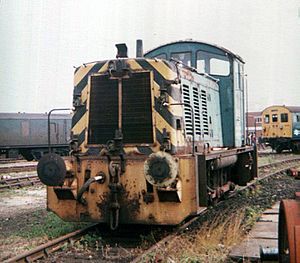British Rail Class 07 facts for kids
Quick facts for kids British Rail Class 07 |
|
 |
|
| D2991 at Eastleigh Works in the 1970s. Still in service at the Works in 2008. | |
| Power type | Diesel-electric |
|---|---|
| Builder | Ruston & Hornsby |
| Serial number | 480686–480699 |
| Model | LSSE |
| Build date | 1962 |
| Configuration | 0-6-0 |
| UIC classification | C |
| Gauge | 4 ft 8 1⁄2 in (1,435 mm) |
| Wheel diameter | 3 ft 6 in (1.067 m) |
| Wheelbase | 8 ft 7+1⁄2 in (2.63 m) |
| Length | 26 ft 9+1⁄2 in (8.17 m) |
| Width | 8 ft 6 in (2.59 m) |
| Height | 12 ft 10 in (3.91 m) |
| Locomotive weight | 42.90 long tons (43.6 t) |
| Fuel capacity | 300 imp gal (1,400 L; 360 US gal) |
| Prime mover | Paxman 6RPHL |
| Traction motors | AEI RTA6652 |
| Top speed | 27.5 mph (44.3 km/h) |
| Power output | Engine: 275 hp (205 kW) |
| Tractive effort | Maximum: 28,240 lbf (125.6 kN) |
| Train heating | None |
| Train brakes | Vacuum, some later dual (Air & Vacuum) |
| Career | British Railways |
| Number in class | 14 |
| Number | D2985–D2998, later 07001–07014 |
| Axle load class | RA 7 (RA 6 from 1969) |
| Retired | May 1973 – July 1977 |
The British Rail Class 07 diesel locomotive is a special type of train called a shunter. It has an off-centre cab, which means the driver's cabin is not in the middle. These powerful machines were built to work in busy places like Southampton Docks. Their main job was to replace older SR USA Class steam locomotives that used to do the same work.
These locomotives are known as 0-6-0 diesel-electric shunters. This means they have no leading wheels, six driving wheels, and no trailing wheels. They were built by a company called Ruston & Hornsby in 1962. A total of 14 of these locomotives were made.
Contents
What is a Shunter?
A shunter is a type of locomotive designed for moving railway wagons or carriages short distances. They work in places like train yards, docks, or industrial areas. Their job is to arrange trains, move wagons to be loaded or unloaded, and generally keep things organized. They need to be strong and able to pull heavy loads slowly.
Why the Class 07 was Special
The Class 07 was a diesel-electric locomotive. This means it uses a diesel engine to power a generator, which then creates electricity. This electricity powers electric motors that turn the wheels. This system is different from steam engines, which use boiling water to create power. Diesel-electric engines are often more efficient and easier to maintain.
Designed for Docks
These locomotives were specifically built for the busy Southampton Docks. Docks are places where ships load and unload cargo. Trains are used to move goods to and from the ships. The Class 07s were perfect for this job because they were strong enough to pull heavy loads and nimble enough to navigate the tight curves and many tracks found in a dockyard.
Numbers and Names
When they were first built, these locomotives had numbers starting with "D". They were numbered from D2985 to D2998. Later, the British Rail system changed how trains were numbered. This new system was called TOPS (Total Operations Processing System). Under TOPS, most of the Class 07s got new numbers from 07001 to 07013. One locomotive, D2998, kept its original number for a while before also being renumbered.
Life and Retirement
The Class 07 locomotives worked hard for British Rail for many years. They were very useful in the docks. However, like all machines, they eventually reached the end of their main service life. They started to be retired from British Rail service between May 1973 and July 1977. Even after retirement, some of them continued to work for other companies or were preserved. For example, D2991 (which became 07007) was still working at Eastleigh Works in 2008!
Images for kids



